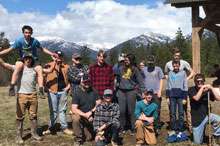No products in the cart.
Land-Savers

Connecting Children to Nature
By Mike Turnlund
When I began my first year teaching at a small rural high school in Idaho’s scenic panhandle—surrounded by forests and water and mountains—it was a shock to realize that many of my students might just as well have been living in a sprawling metropolitan area. It was as if I had a classroom full of inner-city kids, for whom nature is a foreign place. A place they have read about, seen on television, but which is not a part of their experiences, their reality. Nature is wild—a city park or a ball field is not wild. Many of my students had never or rarely engaged in any outdoor activities, such as hiking, fishing, or camping. Most preferred to stay home and play video games or hang out with friends via their smart phones. A fun activity was going shopping in the big city. Say what?
Perhaps I exaggerate, but not by much. A survey published recently by Pew Research shows the typical American teenager spends an average of nine hours a day, seven days a week online—that is, interacting with a screen, whether a television, a computer monitor, or a smart phone. So, between school, maybe after-school sports, and the internet, there’s little time left for nature.
This is where Regan Plumb and others at the Kaniksu Land Trust (KLT) enter the scene. In northern Idaho, they’ve provided an answer to the question of how to get these kids into nature and to help them connect with the outdoors in a meaningful way.
This content is available for purchase. Please select from available options.
Register & Purchase Purchase Only
Register & Purchase Purchase Only

